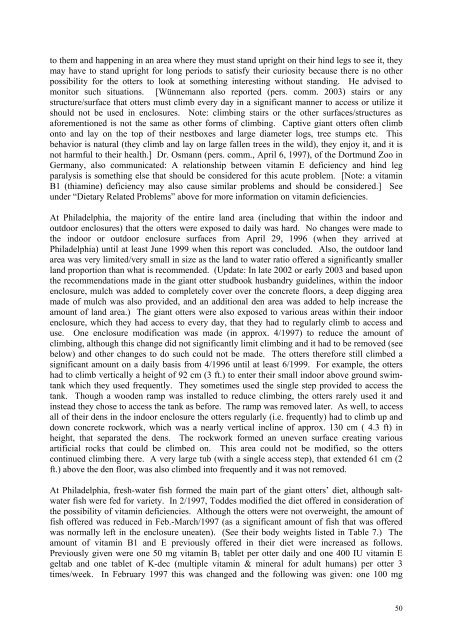International Giant Otter Studbook Husbandry and Management
International Giant Otter Studbook Husbandry and Management
International Giant Otter Studbook Husbandry and Management
You also want an ePaper? Increase the reach of your titles
YUMPU automatically turns print PDFs into web optimized ePapers that Google loves.
to them <strong>and</strong> happening in an area where they must st<strong>and</strong> upright on their hind legs to see it, they<br />
may have to st<strong>and</strong> upright for long periods to satisfy their curiosity because there is no other<br />
possibility for the otters to look at something interesting without st<strong>and</strong>ing. He advised to<br />
monitor such situations. [Wünnemann also reported (pers. comm. 2003) stairs or any<br />
structure/surface that otters must climb every day in a significant manner to access or utilize it<br />
should not be used in enclosures. Note: climbing stairs or the other surfaces/structures as<br />
aforementioned is not the same as other forms of climbing. Captive giant otters often climb<br />
onto <strong>and</strong> lay on the top of their nestboxes <strong>and</strong> large diameter logs, tree stumps etc. This<br />
behavior is natural (they climb <strong>and</strong> lay on large fallen trees in the wild), they enjoy it, <strong>and</strong> it is<br />
not harmful to their health.] Dr. Osmann (pers. comm., April 6, 1997), of the Dortmund Zoo in<br />
Germany, also communicated: A relationship between vitamin E deficiency <strong>and</strong> hind leg<br />
paralysis is something else that should be considered for this acute problem. [Note: a vitamin<br />
B1 (thiamine) deficiency may also cause similar problems <strong>and</strong> should be considered.] See<br />
under “Dietary Related Problems” above for more information on vitamin deficiencies.<br />
At Philadelphia, the majority of the entire l<strong>and</strong> area (including that within the indoor <strong>and</strong><br />
outdoor enclosures) that the otters were exposed to daily was hard. No changes were made to<br />
the indoor or outdoor enclosure surfaces from April 29, 1996 (when they arrived at<br />
Philadelphia) until at least June 1999 when this report was concluded. Also, the outdoor l<strong>and</strong><br />
area was very limited/very small in size as the l<strong>and</strong> to water ratio offered a significantly smaller<br />
l<strong>and</strong> proportion than what is recommended. (Update: In late 2002 or early 2003 <strong>and</strong> based upon<br />
the recommendations made in the giant otter studbook husb<strong>and</strong>ry guidelines, within the indoor<br />
enclosure, mulch was added to completely cover over the concrete floors, a deep digging area<br />
made of mulch was also provided, <strong>and</strong> an additional den area was added to help increase the<br />
amount of l<strong>and</strong> area.) The giant otters were also exposed to various areas within their indoor<br />
enclosure, which they had access to every day, that they had to regularly climb to access <strong>and</strong><br />
use. One enclosure modification was made (in approx. 4/1997) to reduce the amount of<br />
climbing, although this change did not significantly limit climbing <strong>and</strong> it had to be removed (see<br />
below) <strong>and</strong> other changes to do such could not be made. The otters therefore still climbed a<br />
significant amount on a daily basis from 4/1996 until at least 6/1999. For example, the otters<br />
had to climb vertically a height of 92 cm (3 ft.) to enter their small indoor above ground swimtank<br />
which they used frequently. They sometimes used the single step provided to access the<br />
tank. Though a wooden ramp was installed to reduce climbing, the otters rarely used it <strong>and</strong><br />
instead they chose to access the tank as before. The ramp was removed later. As well, to access<br />
all of their dens in the indoor enclosure the otters regularly (i.e. frequently) had to climb up <strong>and</strong><br />
down concrete rockwork, which was a nearly vertical incline of approx. 130 cm ( 4.3 ft) in<br />
height, that separated the dens. The rockwork formed an uneven surface creating various<br />
artificial rocks that could be climbed on. This area could not be modified, so the otters<br />
continued climbing there. A very large tub (with a single access step), that extended 61 cm (2<br />
ft.) above the den floor, was also climbed into frequently <strong>and</strong> it was not removed.<br />
At Philadelphia, fresh-water fish formed the main part of the giant otters’ diet, although saltwater<br />
fish were fed for variety. In 2/1997, Toddes modified the diet offered in consideration of<br />
the possibility of vitamin deficiencies. Although the otters were not overweight, the amount of<br />
fish offered was reduced in Feb.-March/1997 (as a significant amount of fish that was offered<br />
was normally left in the enclosure uneaten). (See their body weights listed in Table 7.) The<br />
amount of vitamin B1 <strong>and</strong> E previously offered in their diet were increased as follows.<br />
Previously given were one 50 mg vitamin B 1 tablet per otter daily <strong>and</strong> one 400 IU vitamin E<br />
geltab <strong>and</strong> one tablet of K-dec (multiple vitamin & mineral for adult humans) per otter 3<br />
times/week. In February 1997 this was changed <strong>and</strong> the following was given: one 100 mg<br />
50

















